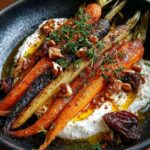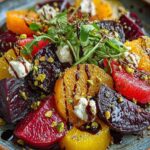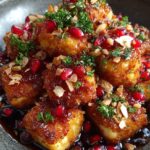What is Mahalabia Made Of? Discover the Ingredients and Preparation
Mahalabia, also known as Muhallebi, is a traditional Middle Eastern dessert cherished by many across different regions. With its light and creamy texture, Mahalabia has been enjoyed as a chilled milk pudding, often flavored with rose water or orange blossom water and garnished with nuts or fresh fruits. The simplicity of this dish makes it both easy to prepare and deeply satisfying.
This article will break down what mahalabia is made of, explore its regional variations, guide you through the preparation process, and showcase the different ways to serve and enjoy this classic dessert.
What is Mahalabia?
Mahalabia is a milk-based pudding that originated in the Middle East. Although its ingredients are simple, the combination of elements results in a rich and silky dessert.
Basic Ingredients of Mahalabia
The ingredients for traditional mahalabia include:
- Milk: Milk serves as the base, giving the pudding its creamy texture. You can use whole milk, or opt for almond or coconut milk to create a dairy-free or vegan version.
- Cornstarch: Cornstarch thickens the pudding, giving it a smooth and velvety consistency. Some variations may use rice flour instead.
- Sugar: The sugar sweetens the pudding. Adjust the amount depending on how sweet you want the dessert to be.
- Rose Water or Orange Blossom Water: These floral waters add the signature aroma that gives mahalabia its distinct flavor. Rose water is more common, but orange blossom water provides a fresh, citrus-like alternative.
These ingredients come together to form a simple yet delightful dessert.
Optional Additions and Garnishes
While the basic ingredients remain the same, mahalabia often comes with toppings that add texture and flavor:
- Chopped Pistachios: These nuts add crunch and vibrant color to the dish.
- Rose Petals: Often sprinkled on top, they enhance the floral flavor and presentation.
- Fresh Fruits: Fruits like strawberries or pomegranate seeds add a fresh and juicy contrast to the creamy pudding.
- Ground Cinnamon or Honey: These ingredients introduce warmth and an extra layer of sweetness.
For pairing ideas with Middle Eastern dishes, see this guide to Shish Tawook for more delicious Middle Eastern meals.
Regional Variations of Mahalabia
Different regions in the Middle East have put their own spin on mahalabia, creating diverse versions of this beloved dessert.
Egyptian Mahalabia
In Egypt, the version of mahalabia uses whole milk and rose water. Egyptians usually top it with crushed pistachios or coconut flakes. It has a slightly thicker consistency compared to other regions, giving it a more indulgent feel.
Lebanese Mahalabia
Lebanon prefers using orange blossom water over rose water. This provides a citrus-like fragrance that complements the sweetness of the dish. Lebanese Mahalabia is lighter in texture and is often topped with ground almonds or cashews.
Turkish Sutlac
In Turkey, a similar dessert called Sutlac incorporates rice into the dish. This addition makes the pudding thicker and more filling compared to its creamier counterparts.
Syrian and Jordanian Mahalabia
Syria and Jordan add mastic (a resin with herbal and pine-like flavors) to their Mahalabia. This gives the dessert a slightly unique taste, enjoyed especially during Ramadan as a post-iftar treat.
For more insights on Middle Eastern dessert traditions, check out this guide to knafeh.
Step-by-Step Guide to Making Mahalabia
Making mahalabia is simple and requires just a few steps. Here’s how you can make this delicious dessert at home:
Ingredients:
- 4 cups of whole milk (or almond milk for a vegan option)
- 5 tablespoons cornstarch (or rice flour)
- ½ cup sugar
- 1 tablespoon rose water (or orange blossom water)
- Optional: chopped pistachios, rose petals, fresh fruit for garnish
Instructions:
- Mix the Milk and Cornstarch: In a saucepan, whisk the milk and cornstarch until smooth and free of lumps.
- Add Sugar and Heat: Add the sugar to the milk mixture. Place the saucepan on medium heat and stir constantly to prevent clumping. The mixture should thicken as the cornstarch activates.
- Thicken the Mixture: Stir the mixture continuously for about 10 minutes, or until it thickens to a pudding-like consistency.
- Add Flavoring: Once the mixture has thickened, remove it from heat and stir in the rose water or orange blossom water.
- Pour and Chill: Pour the pudding into small bowls or ramekins. Let it cool at room temperature, then refrigerate for at least 2 hours.
- Garnish and Serve: Garnish with pistachios, rose petals, or fresh fruits, and serve chilled.
For more fusion dessert ideas, explore this guide on combining Middle Eastern and Western desserts.
The Role of Rose Water in Mahalabia
Rose water plays an essential role in Middle Eastern desserts, and mahalabia is no exception. Here’s why this floral ingredient is crucial:
What is Rose Water?
Rose water is created by distilling rose petals. This process extracts the floral oils and essence from the roses, resulting in a fragrant water used in cooking and baking.
Why Use Rose Water in Mahalabia?
Rose water adds a delicate, fragrant flavor that contrasts beautifully with the creamy milk base of mahalabia. Its floral notes balance the richness of the dessert, making it feel light and aromatic.
If rose water is not available, orange blossom water serves as an excellent substitute. It adds a refreshing citrus aroma without overpowering the dish.
Learn more about rose water and its uses in cooking from this article on rose water.
Serving and Garnishing Mahalabia
Once the mahalabia has set and chilled, it’s time to get creative with garnishing and presentation. Traditionally, the pudding is served in small bowls, topped with nuts or fruits.
Traditional Garnishes
- Chopped Pistachios: These crunchy nuts add both texture and color to the dessert.
- Rose Petals: Sprinkling a few rose petals on top enhances the floral notes of the dish.
- Seasonal Fruits: Fresh fruits such as strawberries, pomegranate seeds, or berries bring a fresh, juicy contrast to the creamy pudding.
Modern Twists
- Coconut Shavings: Toasted coconut adds a tropical twist to the dish.
- Honey Drizzle: A light drizzle of honey adds an extra layer of sweetness and gives the pudding a glossy finish.
- Edible Gold Leaf: For special occasions, edible gold leaf can add a luxurious touch to the presentation.
For more tips on presenting Middle Eastern desserts, see this article on creative dessert toppings.
What to Serve with Mahalabia
Mahalabia is a versatile dessert, pairing well with a variety of Middle Eastern dishes. Here are some serving suggestions:
- Arabic Mint Tea: A warm cup of mint tea provides a refreshing contrast to the creamy mahalabia.
- Shakshuka: For a brunch setting, pairing the pudding with a savory dish like shakshuka creates a balanced meal.
- Grilled Chicken: After a hearty meal of grilled meats such as Shish Tawook or Lamb Kebabs, mahalabia serves as a light and refreshing dessert.
For more pairing suggestions, check out this guide to Middle Eastern dishes.
FAQs about Mahalabia
1. What is Mahalabia made of?
Mahalabia consists of milk, cornstarch, sugar, and either rose water or orange blossom water for flavoring. The dessert is often garnished with chopped pistachios, rose petals, or fresh fruits like pomegranate seeds.
2. Can I make vegan Mahalabia?
Yes! To make a vegan version, substitute the milk with plant-based options like almond milk or coconut milk. You can also use rice flour in place of cornstarch for thickening.
3. How do I serve Mahalabia?
Mahalabia is best served chilled and garnished with nuts, rose petals, or fruits. It pairs well with mint tea or after a meal of grilled meats or stews.
4. What’s the difference between Mahalabia and rice pudding?
Mahalabia is thickened with cornstarch or rice flour, giving it a smooth, pudding-like texture. Rice pudding, on the other hand, contains actual rice grains, resulting in a more textured consistency.
Conclusion: Why Mahalabia is a Beloved Middle Eastern Dessert
Mahalabia’s simplicity and versatility have cemented its place as a cherished dessert across the Middle East. Whether you enjoy it with rose water or prefer a modern twist with coconut shavings, this creamy milk pudding is perfect for any occasion. You can easily customize the dessert by adjusting the flavorings, garnishes, or even switching to a vegan-friendly version.
For more ideas on creating Middle Eastern desserts, check out this guide to fusion dessert ideas.
I’m Billy, a classically trained culinary school graduate from The Culinary Institute of America with over 12 years in the restaurant industry and over 19 years of cooking experience.









